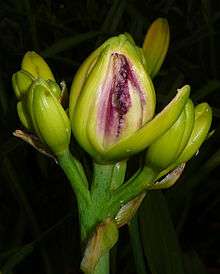Contarinia quinquenotata
Contarinia quinquenotata is a small midge which infests the flower buds of Hemerocallis species and cultivars causing the buds to remain closed and rot.[2] It is a pest within the horticultural trade in several parts of the world.[3] It is known by the common names of daylily gall midge and hemerocallis gall midge.[4]
| Contarina quinquenotata | |
|---|---|
 | |
| Damage to the bud of a Hemerocallis flower from larvae of C. quinquenotata | |
| Scientific classification | |
| Kingdom: | |
| Phylum: | |
| Class: | |
| Order: | |
| Family: | |
| Genus: | |
| Species: | C. quinquenotata |
| Binomial name | |
| Contarinia quinquenotata | |
Description
Adults are tiny greyish-brown alate midges about 2 mm long. Females deposit their eggs with their long, penetrating ovipositors into developing Hemerocallis flower buds during May through early July. This fly is difficult to see when it is flying.[5]
Life cycle
This fly has one annual cycle. It mates shortly after emerging from its winter state as a puparium. Females lay eggs inside developing Hemerocallis buds which hatch into 2-mm-long, elongate, legless white larvae. Their presence and feeding causes distortion of bud tissues and failure of buds to open. Infested buds characteristically become more globular than normal, elongate Hemerocallis buds, tepals within buds become thickened, and a watery liquid is present between the tepals in which the larvae live. A few through hundreds of larvae live within a single bud. Larvae emerge from disfigured buds and drop into the soil where they pupate, spend the winter as pupae, and emerge as adults in the following spring.[5]
Distribution
Cotarinia quinquenotata probably originated in Asia where wild Hemerocallis are native.[5] It occurs only in gardens or plant nurseries which contain Hemerocallis.[5] The midge has been slowly spreading across the world in infested Hemerocallis plants. This fly was first noted in the United Kingdom in 1989 and has now spread to many parts of the United Kingdom.[5] It was first reported in Canada in 2001 and has spread into the USA.[6]
The spread is assumed to occur from larvae within buds of imported plants or the soil in plant containers.[5]
Commercial impact
Devaluation of infested plants by their failure to produce the attractive flowers favoured by gardeners for their colourful displays. Plants can safely be shipped only without their flower scapes and with bare roots.[5] The need to control the midge by whatever means increases the cost of Hemerocallis plants.
References
- Contarina quinquenotata, Encyclopedia of Life, retrieved 13 June 2014
- "Hemerocallis Gall Midge". American Hemerocallis Society. Retrieved June 12, 2014.
- "Continaria quinquenotata". Phytosanitary Alert System. North American Plant Protection Organization. 2014. Retrieved 12 June 2014.
- Hemerocallis gall midge, Royal Horticultural Society, 2014
- McLean, Ian (20 Aug 2011). "Contarinia quinquenotata". GB Non-natives Fact Sheet Editor. GB Non-natives species secretariat. Retrieved 13 June 2014.
- "Continaria quinquenotata". Invasive species - Invertebrates. Encyclopedia of Puget Sound. 2014. Retrieved 12 June 2014.
External links
- American Hemerocallis Society for further images